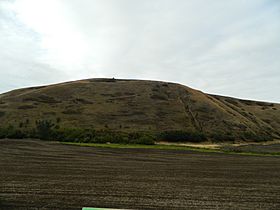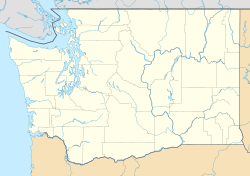Lewis and Clark Trail-Travois Road facts for kids
Quick facts for kids |
|
|
Lewis and Clark Trail–Travois Road
|
|

Trail in the foreground
|
|
| Location | 5 miles (8.0 km) east of Pomeroy on US 12 |
|---|---|
| Nearest city | Pomeroy, Washington |
| Area | 5 acres (2.0 ha) |
| NRHP reference No. | 74001952 |
| Added to NRHP | January 11, 1974 |
The Lewis and Clark Trail–Travois Road is a special historic place in Washington. It is located about 5 miles (8 km) east of Pomeroy, Washington, right on U.S. Route 12. This site protects a part of an old Native American trail.
This trail was used by the famous explorers Lewis and Clark during their journey in 1805–1806. They even wrote about this trail in their journals! Because of its history, the site was added to the National Register of Historic Places in 1974.
What Makes This Trail So Special?
This historic site is important for several reasons. It shows us a piece of the past from the 1805–1806 Lewis and Clark Expedition. It also includes a very old trail that was important to Native Americans long ago. Scientists can still learn a lot from this site today.
One of the explorers, Meriwether Lewis, likely described this very spot. On May 3, 1806, he wrote about continuing "up the Creek bottoms" to a place where the "roade leaves the [Pataha] Creek and assends the hill up to the high plains." This sounds like the area preserved at the site.
The Travois: An Ancient Way to Travel
The word "travois" refers to a special tool used by Native Americans. It was a simple way to move their belongings. A travois was made of two long poles. These poles were tied together and dragged behind a horse or a dog. A hammock or platform was slung between the poles to carry items.
When travois were pulled along the ground, they left deep, parallel tracks. You can still see these tracks today at the Lewis and Clark Trail–Travois Road site! A quarter-mile (0.4 km) section of these original tracks is preserved here. This trail is sometimes called the Nez Perce Trail. It was the same path followed by the Lewis and Clark Expedition.



